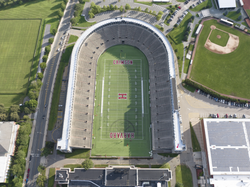
Back Harvard Stadium German Harvard Stadium Spanish ورزشگاه هاروارد Persian Harvard Stadium French Harvard Stadium NB Harvard Stadium Polish Harvard Stadium Portuguese Гарвард Стэдиум Russian Harvard Stadium Swedish 哈佛體育場 Chinese
 | |
 Aerial view of Harvard Stadium in August 2023 | |
 | |
| Location | 95 N. Harvard Street Boston, Massachusetts, U.S. |
|---|---|
| Owner | Harvard University |
| Operator | Harvard University |
| Capacity | 25,000 (1952–present)
Former capacity: List
|
| Surface | FieldTurf (2006–present) Natural grass (1903–2005)[1] |
| Construction | |
| Broke ground | July 1903 |
| Opened | November 14, 1903 122 years ago |
| Construction cost | $310,000 ($10.5 million in 2023[2]) |
| Architect | Louis J. Johnson, Class of 1887 |
| Tenants | |
| |
| Website | |
| gocrimson.com/harvardstadium | |
Harvard Stadium | |
| Location | 60 N. Harvard St., Boston, Massachusetts |
|---|---|
| Coordinates | 42°21′59″N 71°7′38″W / 42.36639°N 71.12722°W |
| Area | 11 acres (4.5 ha) |
| Built | 1903 |
| Architect | McKim, Charles F.; et al. |
| Architectural style | Classical Revival |
| NRHP reference No. | 87000757[4] |
| Added to NRHP | February 27, 1987 |
Harvard Stadium is a U-shaped college football stadium in the Allston neighborhood of Boston, Massachusetts. The Stadium is one of only four athletic facilities that are considered National Historic Landmarks.[5] The stadium is owned and operated by Harvard University and is home to the Harvard Crimson football program. In its current form, Harvard Stadium seats just over 25,000 spectators.[6]
Built in 1903, it was a pioneering execution of reinforced concrete in the construction of large structures. Because of its early importance in these areas, and its influence on the design of later stadiums, it was designated a National Historic Landmark in 1987.[7] The stadium is the nation's oldest permanent concrete structure dedicated to intercollegiate athletics. It seated up to 57,166 in the past, as permanent steel stands (completing a stadium shape)[8] were installed in the stadium's northeast end zone in 1929. They were torn down after the 1951 season, due to deterioration and reduced attendance. Afterward, there were smaller temporary steel bleachers across the stadium's open end until the building of the Murr Center (which is topped by the new scoreboard) in 1998.
Harvard Stadium hosted one Boston Patriots season in 1970. It was their first season in the NFL after the AFL–NFL merger and their last before becoming the New England Patriots. The team moved to Schaefer Stadium in Foxborough the following season.
- ^ Lisa Kennelly, "Extreme Makeover: Harvard Stadium", Harvard Crimson, April 13, 2006.
- ^ 1634–1699: McCusker, J. J. (1997). How Much Is That in Real Money? A Historical Price Index for Use as a Deflator of Money Values in the Economy of the United States: Addenda et Corrigenda (PDF). American Antiquarian Society. 1700–1799: McCusker, J. J. (1992). How Much Is That in Real Money? A Historical Price Index for Use as a Deflator of Money Values in the Economy of the United States (PDF). American Antiquarian Society. 1800–present: Federal Reserve Bank of Minneapolis. "Consumer Price Index (estimate) 1800–". Retrieved February 29, 2024.
- ^ "Harvard Stadium Football History". Harvard University. Retrieved April 11, 2016.
- ^ "National Register Information System". National Register of Historic Places. National Park Service. March 13, 2009.
- ^ "Campus Spotlight: Harvard Stadium". Harvard. Retrieved 26 January 2025.
- ^ "Campus Spotlight Harvard Stadium". Harvard University. Retrieved October 12, 2023.
- ^ "NRHP nomination for Harvard Stadium". Commonwealth of Massachusetts. Archived from the original on 2015-09-05. Retrieved 2014-06-02.
- ^ "Aerial view of Harvard Stadium". Newton, Massachusetts): Digital Commonwealth. 1930. Retrieved December 1, 2017.


